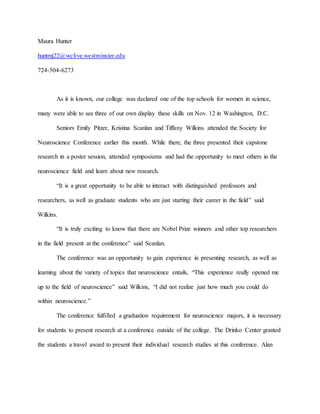
Westminster neuroscience students present at conference
- 1. Maura Hunter huntmj22@wclive.westminster.edu 724-504-6273 As it is known, our college was declared one of the top schools for women in science, many were able to see three of our own display these skills on Nov. 12 in Washington, D.C. Seniors Emily Pitzer, Kristina Scanlan and Tiffany Wilkins attended the Society for Neuroscience Conference earlier this month. While there, the three presented their capstone research in a poster session, attended symposiums and had the opportunity to meet others in the neuroscience field and learn about new research. “It is a great opportunity to be able to interact with distinguished professors and researchers, as well as graduate students who are just starting their career in the field” said Wilkins. “It is truly exciting to know that there are Nobel Prize winners and other top researchers in the field present at the conference” said Scanlan. The conference was an opportunity to gain experience in presenting research, as well as learning about the variety of topics that neuroscience entails, “This experience really opened me up to the field of neuroscience” said Wilkins, “I did not realize just how much you could do within neuroscience.” The conference fulfilled a graduation requirement for neuroscience majors, it is necessary for students to present research at a conference outside of the college. The Drinko Center granted the students a travel award to present their individual research studies at this conference. Alan
- 2. Gittis and Robin McGovern, the students’ capstone advisors, have been regularly attending this conference for years. The conference lasts about a week and 30,000 people from around the globe attend. It gives researchers the opportunity to see lectures from distinguished individuals in the field and attend symposiums, poster sessions, workshops and meetings, as well as other events related to neuroscience. The Society for Neuroscience website states that it is a nonprofit organization and that their mission is simple: advance the understanding of the brain and nervous system by bringing together scientists of diverse backgrounds; provide professionals development activities information, and education resources for neuroscientists at all stages of their careers; promote public information and general education about the nature of scientific discovery and the results and implications of the latest neuroscience research; and inform legislators and other policymakers about new scientific knowledge and recent developments and their implications for public policy, societal benefits, and continued scientific progress. “I have only been here a few days, but it has already opened my eyes to the amount of amazing research topics and studies within the field,” said Pitzer. She was amazed at what vast individuals were at the conference, from Nobel Prize winners to other undergrads like her, who were all incredibly passionate about neuroscience research. “This experience has definitely motivated me even more to pursue research and has made me even more passionate about the field.” After graduation, Pitzer wishes to be a part of a neuroscience program and earn her PhD so she can eventually conduct research. After attending the conference in 2009, Scanlan was still amazed this time around.
- 3. “It is interesting to see the most current research out there,” said Scanlan and she plans to attend medical school and become a physician. “I believe that I will take away a new perspective on not only my own field of research on autism spectrum disorders, but other areas of neuroscience as well.” Believing this was a great opportunity; Wilkins learned how to present research as well as discovered a variety of new and diverse topics within the field. Wilkins plans on attending medical school and specializing in neurosurgery. “This was an amazing experience”, said Pitzer, “The conference fulfilled one of its main purposes: it brought together so many people from diverse backgrounds and educated us all on the latest neuroscience information.” Fulfilling this graduation requirement ended up being an opportunity for these students to learn even more about their chosen field, neuroscience.